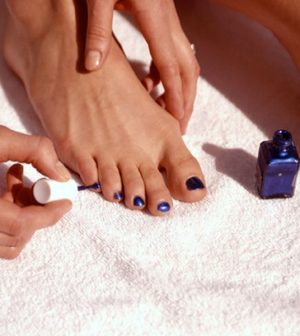- Navigating Your Midlife Crisis: Embracing New Possibilities
- City Raccoons Showing Signs of Domestication
- Mapping the Exposome: Science Broadens Focus to Environmental Disease Triggers
- One Week Less on Social Media Linked to Better Mental Health
- Your Brain Changes in Stages as You Age, Study Finds
- Some Suicide Victims Show No Typical Warning Signs, Study Finds
- ByHeart Formula Faces Lawsuits After Babies Sickened With Botulism
- Switch to Vegan Diet Could Cut Your Greenhouse Gas Emissions in Half
- Regular Bedtime Does Wonders for Blood Pressure
- Dining Alone Could Mean Worse Nutrition for Seniors
Put Your Best Feet Forward, Despite Diabetes

If you have diabetes, it’s time to think about your feet.
“Diabetes is a multisystem disease,” Dr. Ronald Lepow explained in a news release from the Baylor College of Medicine in Houston. “Circulation in the feet and legs may be diminished because there are problems with blood vessels that get narrowed or clogged as a result of the diabetes.
“A major cause of foot problems in diabetics is lack of blood flow,” added Lepow, a professor of orthopedic surgery at Baylor.
This can cause calloused or injured areas on the feet to heal more slowly, which can lead to ulcers or infections.
Another problem is that diabetes-related nerve damage can affect the normal oil and moisture on the skin of the feet. That results in dry and cracking skin, which allows bacteria to get in and cause infections or ulcers, Lepow said.
What to do?
Lepow says it’s important for anyone with diabetes to wash and dry their feet and inspect them for scratches, blisters, injuries, cuts and bruises every day. Once feet are dry, apply a cream that’s at least 20 to 40 percent urea.
Proper footwear is also crucial for people with diabetes. Because of the special needs, Lepow suggests seeing a podiatrist for help.
For instance, you’ll need a wide and deep toe box. That will allow free movement of your toes and reduce friction and pressure. Also important are a solid sole and cushioning in areas that store-bought shoes typically do not have, he said.
Podiatrists also can recommend different types of custom shoe inserts, Lepow said.
Also, wear socks that don’t cause friction or pressure. Cotton socks are recommended. People whose feet sweat a lot should wear moisture-wicking socks. And, Lepow said, everyone should wear thicker socks in the winter.
More information
The American Diabetes Association has more on foot care.
Source: HealthDay
Copyright © 2025 HealthDay. All rights reserved.










